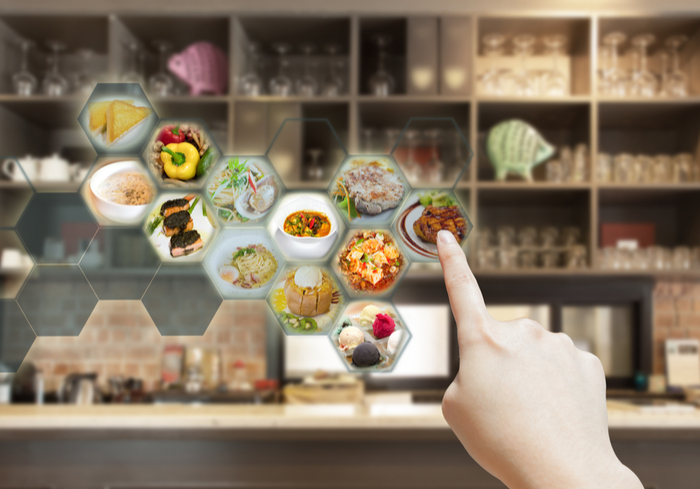
It has been a year of innovations for quick-service restaurants (QSRs), with chains rolling out new digital technologies to help diners order and pay for food without having to wait in line. From kiosks to online ordering and drive-through lanes, these merchants sought to provide their customers with digital alternatives to ordering at the counter in 2018.
Below, PYMNTS rounds up the top restaurant innovations of the year and sheds light on how restaurants tapped into new technologies to better serve their diners. These are just some examples of how restaurant technology innovations powered convenient restaurant experiences this year:
Online Ordering Expansions
Yum! Brands began the year by announcing that it was teaming up with Grubhub to provide online ordering and delivery for its Taco Bell and KFC brands, as news also surfaced that it would purchase a 3 percent stake in the food-delivery platform. In February, Grubhub CEO Matt Maloney told CNBC that the tie-up would “ accelerate the expansion of our delivery network and amplify our diner acquisition efforts, raising consumer awareness of online ordering and driving more volume for all restaurants across our platform.”
Months later, in December, Yum! Brands’ Pizza Hut unit announced that it would acquire online ordering software and service provider QuikOrder. In a press release at the time, Pizza Hut did not disclose terms of the deal, but said this was its largest acquisition to date. The chain is no stranger to QuikOrder, however, as Pizza Hut U.S. has worked with QuikOrder for close to two decades. Pizza Hut noted that so far this year, about half of its U.S. sales were processed via the QuikOrder platform.
The offerings come as managers of QSRs are seeing digital ordering options as a valuable offering. According to the PYMNTS Restaurant Readiness Index, 64.5 percent of QSR managers believed that online/app ordering is important to a restaurant’s success. And an even higher share of QSR customers — 83.6 percent — have that view.
Restaurant Kiosk Roll Outs
McDonald’s beefed up its digital ordering efforts with kiosks this year, as it turned its eye to customer experience and choice. In June, it was reported that the QSR chain planned to bring the self-service stations to 1,000 locations in the U.S. each quarter for the following eight to nine quarters. McDonald’s CEO Steve Easterbrook told CNBC at the time that customers previously had to use a drive-through or go to the counter to order food.
But the company was rolling out more options: Of his customers, Easterbrook told the outlet: “They can order through mobile, they can come curbside and we’ll run it out as well as the existing traditional ways. You can pay in different ways and customize your food in different ways.” And, on a third-quarter earnings call with analysts in October, Easterbrook noted that the chain is seeing higher average tickets with the popularity and use of self-order kiosks. “We are seeing higher average checks of the self-order kiosks because people dwell longer,” Easterbrook said.
According to the PYMNTS Restaurant Readiness Index, only 29.5 percent of QSR managers believed that self-service kiosks are important to a restaurant’s success. But a much higher share of QSR customers — 73.9 percent — hold that view.
Restaurant Locker Installations
And, in another trend, QSRs seemingly took a page out of the Amazon (and Home Depot) playbook by implementing pickup lockers. Little Caesars, for instance, introduced pickup lockers that were designed specifically for prepared food. They are heated and come with omnichannel features like prepayment and mobile ordering. In order to use the lockers, customers order through the mobile app or “custom pizza builder.” They then unlock the lockers by entering a three-digit PIN or scanning a code.
Months later, PYMNTS connected with pickup pod startup Minnow. The company provides pods to restaurants that diners can use by placing an order through a restaurant’s app or website. The eatery then, in turn, prepares the food and puts it in the pod. After receiving a notification that their order is ready, Minnow Co-Founder and CEO Steven Sperry told PYMNTS.com in a November interview, diners can open the locker via “a wireless locking mechanism that is controlled by a smartphone app.”
The offerings come as managers of QSRs see digital ordering options as important to their operations. According to the PYMNTS Restaurant Readiness Index, 71 percent of QSR managers believed that in-store fast pickup is important to a restaurant’s success. But a slightly higher share of QSR customers — 84.1 percent — see the option as important.
From pickup lockers to online ordering and kiosks, QSRs upgraded their digital ordering offerings with new technologies. And consumers don’t only have an appetite for fast food: As the index shows, they are eager to embrace new technologies as they head out to their favorite QSR chains, too.